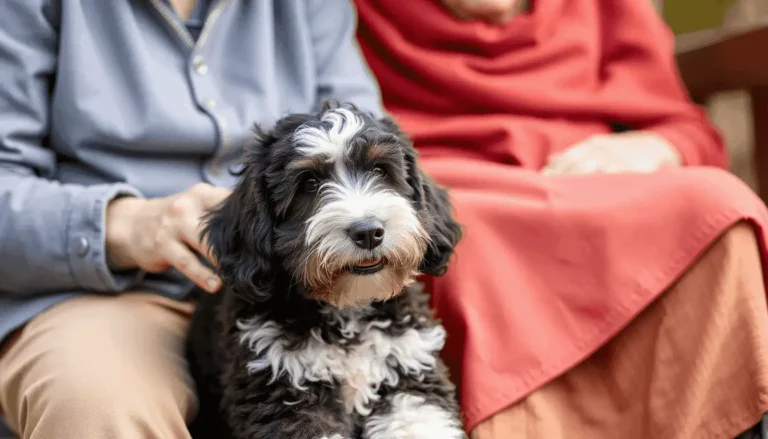Goldendoodle FAQs
62 Real-Life Answers to Common Questions (Care, Behavior, Training)
1. Is a Goldendoodle rare?

No, Goldendoodles are not rare — in fact, they’re one of the most popular designer dog breeds worldwide. Their rise in popularity comes from their loving temperament, low-shedding coat, and intelligence. However, certain types within the breed, like black, merle, or parti-color Goldendoodles, may be less common. But overall, Goldendoodles themselves are widely available through breeders and rescues.
2. Are Goldendoodles good dogs?
Absolutely — Goldendoodles are known for being friendly, intelligent, and affectionate. They combine the best traits of Golden Retrievers and Poodles, making them playful yet gentle, great with kids, and easy to train. Their social nature and eagerness to please make them ideal for families, first-time dog owners, and even therapy work. With proper care and attention, they become incredibly loyal and joyful companions.
3. Can you get black Goldendoodles?
Yes, you can get Goldendoodles from reputable breeders, rescue organizations, or adoption centers. They’re widely available due to their popularity. Make sure to choose a breeder who health-tests the parents and raises puppies in a loving environment. If you prefer adoption, many Goldendoodles also need rehoming through rescue groups. Just be ready for their grooming needs, energy, and affectionate nature — they’re worth every bit of care.
4. How long do Golden doodles live?
Goldendoodles typically live between 10 to 15 years, depending on their size, genetics, and overall care. Miniature Goldendoodles often live slightly longer than standard ones. A healthy diet, regular exercise, routine vet checkups, and lots of love all contribute to a longer, happier life. Choosing a puppy from health-tested parents also increases the chances of a strong, long-living companion by your side.
5. Do Goldendoodles bark a lot?

Goldendoodles are moderate barkers. They may bark when excited, alert, or if they’re bored — but they’re not known for being yappy. Proper training and socialization from a young age helps them learn when to bark and when not to. Some may bark more if they don’t get enough mental stimulation or feel anxious when left alone. Overall, with the right balance of exercise and attention, they stay fairly quiet and content.
6. What is the personality of a black Goldendoodle?
Black Goldendoodles are affectionate, playful, loyal, and smart — just like any Goldendoodle, regardless of color. They bond deeply with their family, are usually gentle with kids, and love being involved in everything you do. They’re social, love other dogs, and often show a cheerful, silly side. Their intelligence makes them easy to train, and they’re emotionally tuned in to your feelings. Their glossy black coat just adds to their charm and elegance!
7. What is bad behavior in Goldendoodles?
Goldendoodles are generally well-behaved, but like any dog, they can develop unwanted behaviors if bored or untrained. Common issues include jumping on people, chewing furniture, barking too much, or pulling on the leash. Some may nip during puppy teething or become overly clingy. These behaviors often come from a lack of structure, attention, or exercise. With consistency, positive reinforcement, and patience, most Goldendoodles grow out of these habits easily.
8. Do Goldendoodles like to cuddle?
Yes, most Goldendoodles absolutely love cuddling! They’re affectionate dogs who crave closeness with their humans. Whether it’s curling up on the couch, laying across your feet, or snuggling at bedtime, cuddling makes them feel secure and loved. Of course, every dog is unique — some prefer laying nearby instead of full-body hugs. But overall, Goldendoodles are known for their warm hearts and strong desire to be physically close to their family.
9. What is so special about Goldendoodles?

Goldendoodles are a wonderful blend of the intelligence of a Poodle and the gentle, loving nature of a Golden Retriever. They’re often hypoallergenic or low-shedding, which is great for families with allergies. Their goofy, human-like personalities make them incredibly fun to be around. They’re trainable, loyal, friendly with kids and strangers, and thrive in active, affectionate homes. Whether as a therapy dog, hiking buddy, or couch snuggler — they shine in every role.
10. What not to do with a Goldendoodle?
Don’t leave a Goldendoodle alone for too long — they’re people-loving dogs and can develop separation anxiety. Avoid harsh training methods; they respond far better to gentle, positive reinforcement. Don’t skip their grooming needs — their coat can mat quickly if neglected. And don’t underestimate their energy; they need daily physical and mental stimulation. Lastly, don’t feed them human food or overfeed treats — they can gain weight easily.
11. Do Goldendoodles sleep a lot?
Yes, especially as puppies. Goldendoodles can sleep 12–16 hours a day. Puppies may even nap more. Sleep helps their growth, energy balance, and mood. Adult Goldendoodles enjoy rest after exercise or play. If they seem too sleepy, it’s wise to check their diet or health, but overall, they just love comfy spots and long naps with you nearby.
12. Do Goldendoodles get attached to one person?
Goldendoodles bond deeply, and while they love the whole family, they often pick one favorite human. That person usually feeds, trains, or spends the most time with them. Their loyalty runs deep, and they can follow that person around like a shadow. With proper socialization, though, they remain friendly with everyone — not overly possessive or distant from others.
13. What do Goldendoodles love the most?

Goldendoodles absolutely love three things: attention, play, and being with their people. Whether it’s a game of fetch, a car ride, or cuddle time on the couch, they thrive on bonding moments. They also enjoy food rewards and puzzles that challenge their smart minds. But more than anything, they just love being part of your daily life.
14. Are Goldendoodles easy to potty train?
Yes, Goldendoodles are usually quick learners and respond well to routine. Start early, use consistent commands, and reward good behavior. Crate training helps speed up the process. Accidents might happen at first, but with patience and a calm approach, they learn fast. Their eagerness to please makes potty training smoother than with many other breeds.
15. What do Goldendoodles eat?
Goldendoodles do best on a high-quality, balanced dog food — either dry kibble, raw, or gently cooked diets. Protein-rich meals with healthy fats and grains (or grain-free, if needed) support their energy and coat. Treats should be limited and nutritious. Always check with your vet for portion sizes and specific needs based on size, age, and activity.
16. Can Goldendoodles Drink milk?
Small amounts of plain milk may not harm some Goldendoodles, but many dogs are lactose intolerant. This can lead to gas, diarrhea, or upset stomach. Safer options include lactose-free dog milk or plain yogurt in moderation. Always introduce dairy slowly and watch for any reactions. It’s best to avoid giving milk regularly or in large amounts.
17. How long do Goldendoodles live?

Goldendoodles typically live 10 to 15 years, depending on their size and overall health. Mini Goldendoodles often live slightly longer than standards. A nutritious diet, regular vet care, and plenty of love and activity can help them thrive. Choosing a puppy from health-tested parents also increases the chance of a long, happy life together.
18. What are Goldendoodles allergic to?
Like many breeds, Goldendoodles can be allergic to chicken, grains, dairy, or certain environmental factors like pollen and dust. Symptoms include itching, ear infections, licking paws, or upset stomach. Food trials and allergy testing help pinpoint the cause. A hypoallergenic diet and regular grooming often reduce allergic reactions and keep your pup comfortable.
19. What is the problem with Goldendoodles?
The main issues with Goldendoodles come from poor breeding. Some may have health problems like hip dysplasia or temperament issues. Their coat needs regular grooming, or it mats badly. They also need plenty of attention and may develop anxiety if left alone too long. Choosing a responsible breeder and committing to care solves most problems.
20. How often should I bathe a Goldendoodle?
Bathing every 4–6 weeks works well for most Goldendoodles. Bathing too often can dry their skin, while too little can lead to matting or odor. Use a gentle, dog-friendly shampoo and always dry their thick coat completely. In between baths, regular brushing keeps them fresh and tangle-free. After muddy play, quick rinses are fine!
21. What is the most common cause of death in Goldendoodles?

The most common causes are cancer, heart disease, and genetic conditions like hip dysplasia or bloat. Larger Goldendoodles may be more at risk of bloat, while older ones may face tumors or organ issues. Regular vet checkups, a balanced diet, and early detection of symptoms help prevent serious issues. Many Goldendoodles live long, happy lives with proper care.
22. Do Goldendoodles get sick easily?
Not usually. Goldendoodles are generally healthy, but they can inherit health issues if bred poorly. Common problems include allergies, hip dysplasia, ear infections, and digestive sensitivities. Regular grooming, a proper diet, and annual vet exams help keep them in top shape. Choosing a puppy from a responsible breeder reduces the risk of inherited conditions significantly.
23. What dog causes the most deaths in the world?
Statistically, the Pit Bull is linked to the highest number of fatal dog attacks globally. However, it’s important to understand that aggression is often due to environment, lack of training, or abuse — not the breed alone. Goldendoodles, on the other hand, are among the gentlest, family-friendly breeds and are rarely linked to aggressive behavior.
24. How big do female Goldendoodles get?
It depends on their type. A standard female Goldendoodle usually weighs 45–65 pounds and stands 20–23 inches tall. Miniature females weigh 25–35 pounds. Genetics from the parents, especially the size of the Poodle parent, determine their adult size. Most females are slightly smaller and lighter than males but just as sturdy and energetic.
25. Which is better, a girl or a boy Goldendoodle?

Both make great pets. Females may mature faster, be slightly more independent, and are often easier to train early. Males are often more playful, affectionate, and goofy. Personality matters more than gender. If spayed/neutered responsibly, both genders are equally lovable, loyal, and well-behaved companions. It comes down to your home, lifestyle, and bonding preference.
26. At what age is a Goldendoodle full grown?
Mini Goldendoodles usually reach full size by 12 months, while standard ones take about 18 months. Mentally, they mature more slowly — often staying playful until age 2 or 3. Their coat may keep changing in texture or curliness for up to a year. Training and routine help balance their energy as they grow.
27. Is a Goldendoodle a deep chested dog?
Yes, most Goldendoodles — especially standards — are considered deep-chested. This body type increases their risk of bloat (gastric torsion), a serious condition. To reduce risk, avoid vigorous exercise right after meals, feed in smaller portions, and use slow-feeders if needed. Knowing this helps you care for their digestion and physical needs properly.
28. Why do Goldendoodles hump so much?
Humping is common and not always sexual. Goldendoodles may hump due to excitement, stress, play behavior, or attention-seeking. Puppies do it more often and usually grow out of it. Neutering helps reduce the urge if done at the right age. Redirection, training, and exercise help curb this behavior without needing to scold or shame.
29. What is the best haircut for a Goldendoodle?

The “Teddy Bear Cut” is the most popular — it gives your Goldendoodle a fluffy, rounded face and short, manageable body hair. It’s cute, low-maintenance, and keeps mats away. The “Lamb Cut” is also common for warmer weather. No matter the style, regular grooming every 6–8 weeks helps your Doodle look great and feel comfortable.
30. Why do Goldendoodles have human eyes?
Goldendoodles often inherit expressive eyes from both parent breeds. Their almond-shaped eyes, paired with thick lashes and deep color, give them a soulful, human-like gaze. This eye contact makes bonding feel even stronger. It’s not magic — just genetics and their emotional connection with people. That “human” look makes them even more lovable.
31. Are Goldendoodles colorblind?
Not completely. Like all dogs, Goldendoodles see fewer colors than humans. They mostly see shades of blue and yellow, but reds and greens appear grayish to them. So while they’re not truly colorblind, their world looks softer and less vibrant. Despite this, they rely more on smell and movement — and they never miss their favorite toy!
32. Why do Goldendoodles always look sad?
Goldendoodles have naturally expressive faces, with big round eyes and slightly droopy brows — which can look “sad.” But don’t worry — it’s usually just their sweet resting face! If your Doodle seems truly down, check for changes in behavior or appetite. Otherwise, that soulful look just adds to their charm (and their ability to win treats!).
33. Why do Goldendoodles show their teeth?

Showing teeth isn’t always aggression. Goldendoodles might “smile” by pulling back their lips — especially when excited or submissive. It can look funny, even alarming, but it’s often harmless. Look at their body language: if the tail’s wagging and eyes are soft, it’s likely a friendly or nervous gesture, not a warning.
34. Why are Goldendoodles so intelligent?
Goldendoodles get their smarts from both sides: Golden Retrievers and Poodles are in the top 5 smartest dog breeds. They learn commands fast, solve puzzles, and often sense your mood. This intelligence makes them easy to train, but they also need mental stimulation. Games, challenges, and positive reinforcement keep their clever minds sharp and happy.
35. What does it mean when a dog shows its belly?
When a Goldendoodle shows its belly, it’s usually a sign of trust and submission. They’re saying, “I feel safe with you.” Belly showing can also be an invitation for rubs — which Doodles love! However, if they’re tense or fearful while doing it, it might be anxiety. Watch their body cues to understand what they’re feeling.
36. Why do Doodles sneeze?
Goldendoodles sneeze for common reasons: dust, pollen, excitement, or playful communication. Sometimes during play, they “fake sneeze” to show they’re having fun. Occasional sneezing is normal, but if it becomes constant, it could mean allergies or nasal irritation. If the sneezing is frequent or sounds odd, a vet check is a good idea.
37. Why do dogs lick you?

Goldendoodles lick to show affection, bond with you, or get your attention. Licking also helps them explore their world and express submission or comfort. It’s their way of saying “I like you” or “You’re part of my pack.” While it’s sweet, too much licking can signal boredom or anxiety, so balance it with play and care.
38. Why does my Goldendoodle smile?
Goldendoodles really do smile — they pull back their lips in a relaxed, happy way. You’ll see it when they’re excited, relaxed, or just happy to see you. It’s often paired with a wagging tail and soft eyes. Their expressive face makes them look more human, and that smile is just one more reason people adore them.
39. Why do Goldendoodles always want to be with you?
Goldendoodles are companion dogs — bred to bond deeply with humans. They love being part of your daily life, whether you’re walking, working, or watching TV. Their loyalty and emotional intelligence make them stick close. It’s not neediness — it’s love. But they can get anxious if left alone too long, so they thrive best with company.
40. Why is my Goldendoodle so clingy?
Clinginess in Goldendoodles comes from their affectionate nature. They form strong bonds and want to stay close. It can also mean they need more mental stimulation or feel anxious when left out. Try giving them routine, activities, and alone-time training. But in most cases, it just means you’ve got a very loving, loyal best friend.
41. Do Goldendoodles need a lot of grooming?

Yes, they do! Goldendoodles have thick, curly or wavy coats that can mat easily. Regular brushing — at least 3–4 times a week — is a must. Without grooming, their fur tangles painfully close to the skin. Routine grooming keeps them clean, happy, and healthy. If you can’t groom at home, monthly professional grooming helps a lot.
42. How often should I brush my Goldendoodle?
Ideally, you should brush your Goldendoodle every other day. Their coat tends to tangle, especially around the ears, belly, and legs. Frequent brushing helps prevent painful mats, keeps their skin healthy, and reduces shedding. It’s also a bonding moment — most Doodles love the attention. Brushing 10–15 minutes a day can save you expensive grooming trips later.
43. Are Goldendoodles hypoallergenic?
Goldendoodles are considered low-allergen dogs, but no dog is 100% hypoallergenic. They shed very little, which helps reduce dander — the main allergy trigger. People with mild allergies often do well with them, especially F1B and multigenerational Goldendoodles. Regular grooming, cleaning, and using HEPA filters can make living with a Doodle more allergy-friendly and comfortable.
44. Do Goldendoodles get ear infections easily?
Yes, they’re prone to ear infections due to their floppy ears and thick hair, which trap moisture and bacteria. Cleaning their ears weekly and drying them after baths or swims helps a lot. Watch for signs like scratching, head shaking, or odor. A gentle ear cleaner and regular checks prevent painful infections and expensive vet visits.
45. Can Goldendoodles swim?

Most Goldendoodles love water and are natural swimmers, thanks to their Golden Retriever heritage. Swimming is a great low-impact exercise for them, especially in hot weather. Always supervise your dog in water, especially the first few times. Some Doodles may need time to get comfortable, so introduce it gently and with encouragement.
46. How to clean a Goldendoodle’s ears?
Use a vet-recommended ear cleaner and cotton balls — never Q-tips. Gently lift the ear flap, squeeze in the solution, massage the base, then wipe out the loosened debris. Check for redness or odor while cleaning. Aim for once a week, especially if your Doodle swims or gets baths often. Clean ears mean a happier, healthier pup.
47. What vaccinations does a Goldendoodle need?
Goldendoodles need all core vaccines: rabies, distemper, parvovirus, and adenovirus. Non-core vaccines may include Bordetella (kennel cough), Lyme disease, and leptospirosis based on lifestyle. Puppies start shots at 6–8 weeks and need boosters over the next few months. Annual or triennial boosters keep them protected. Always follow your vet’s vaccination schedule.
48. Do Goldendoodles overheat easily?
Yes, especially in warm climates or during summer, Goldendoodles can overheat due to their thick coats. Avoid heavy activity during peak heat, provide water, and keep them in shade. Trim, but don’t shave, their coat — it protects against both heat and sunburn. Panting, drooling, and lethargy are signs of overheating — act quickly if noticed.
49. Are Goldendoodles good for first-time dog owners?

Yes! Goldendoodles are one of the best breeds for first-time owners. They’re affectionate, eager to please, intelligent, and relatively easy to train. Their friendly nature and low-shedding coat are bonuses. However, they do need consistent grooming, attention, and exercise. With love and structure, they quickly become loyal, joyful family members.
50. Do Goldendoodles need a backyard?
Not necessarily. Goldendoodles can live happily in apartments or homes without a yard — as long as they get daily walks, playtime, and stimulation. A backyard is a bonus for extra freedom, but it doesn’t replace human interaction or structured exercise. Even with a yard, they need you to engage with them regularly.
51. Are Goldendoodles good with cats?
Yes, with proper introductions, Goldendoodles usually get along well with cats. They’re gentle, social, and non-aggressive. Start introductions slowly and supervise their early interactions. If raised together or properly socialized, they often become great companions. Every dog and cat has a unique personality, but overall, Doodles adjust well in multi-pet households.
52. Can Goldendoodles travel well in cars?
Most Goldendoodles enjoy car rides, especially if introduced young. They’re curious and like being with their family. Use a seatbelt harness or crate for safety. Start with short trips to fun places like the park to create positive associations. Some may get motion sickness early on, but most adjust quickly and travel comfortably.
53. Do Goldendoodles stink?

Goldendoodles generally don’t have a strong dog odor — especially if regularly groomed and their ears are cleaned. Bad smell can come from dirty ears, dental issues, or matted fur trapping moisture. A proper grooming routine, good diet, and clean bedding help keep them smelling fresh. If there’s a sudden odor, consult your vet.
54. Why is my Goldendoodle licking its paws?
Paw licking can mean allergies, dry skin, boredom, or even anxiety. It may also signal an injury or irritation from salt, grass, or chemicals. If licking becomes excessive, inspect the paw and contact your vet. Regular paw cleaning, a healthy diet, and mental stimulation help reduce this behavior.
55. How to tell if my Goldendoodle is in pain?
Signs of pain include limping, whining, hiding, reduced appetite, or sudden behavior changes. A Goldendoodle may also avoid being touched or show stiffness after rest. Subtle signs matter — they often hide pain instinctively. If you notice anything unusual, a quick vet visit can catch issues early and avoid worsening problems.
56. Do Goldendoodles change color over time?
Yes, many Goldendoodles experience coat color changes as they grow — especially in their first year. A dark puppy may lighten or develop highlights, while cream-colored ones may deepen in shade. This is normal and depends on their genetics. It’s part of what makes each Doodle visually unique as they mature.
57. How do I know if my Goldendoodle is happy?

A happy Goldendoodle has a wagging tail, bright eyes, relaxed body, and playful energy. They follow you around, respond well to attention, and enjoy play or cuddle time. If they eat, sleep, and behave normally, that’s a strong sign of happiness. Frequent tail wags and “smiles” are the ultimate Doodle-approved signals!
58. What human food is toxic to Goldendoodles?
Foods like chocolate, grapes, raisins, onions, garlic, xylitol (in gum or peanut butter), and alcohol are toxic to all dogs — including Goldendoodles. Even small amounts can be dangerous. Avoid fatty leftovers and anything seasoned. When in doubt, keep human food out of reach and stick to dog-safe treats.
59. Can Goldendoodles eat eggs?
Yes! Cooked eggs (boiled or scrambled without butter or salt) are a safe, healthy protein source for Goldendoodles. They contain amino acids, vitamins, and good fats. Avoid raw eggs, especially often, as they can cause digestion issues or reduce biotin absorption. Feed in moderation as part of a balanced diet.
60. Should I feed my Goldendoodle raw food?
Raw feeding (BARF diet) is an option, but it must be done carefully. It can offer natural nutrients, but it carries risks like bacterial contamination or nutrient imbalance. Always research thoroughly or consult a vet or canine nutritionist. Some owners see benefits like shinier coats and smaller stools — but it’s not one-size-fits-all.
61. Do Goldendoodles have sensitive stomachs?

Some Goldendoodles do have sensitive stomachs, especially if they inherit it from their Poodle side. Symptoms include vomiting, loose stools, or gas. Stick to high-quality dog food with limited ingredients, and avoid frequent diet changes. Introduce new foods slowly. If problems persist, your vet may suggest allergy tests or special diets.
62. How to stop my Goldendoodle from jumping on people?
Teach a firm “sit” command and reward calm greetings. Ignore them when they jump — no eye contact, no talking — until all four paws are down. Consistency is key. Ask visitors to follow the same rule. Over time, your Doodle will learn that sitting brings attention, while jumping doesn’t.
If you’re just starting your journey with a Goldendoodle, don’t miss our beginner-friendly guide:
👉 Black Goldendoodle Breed Guide: Traits, Grooming & Cost






